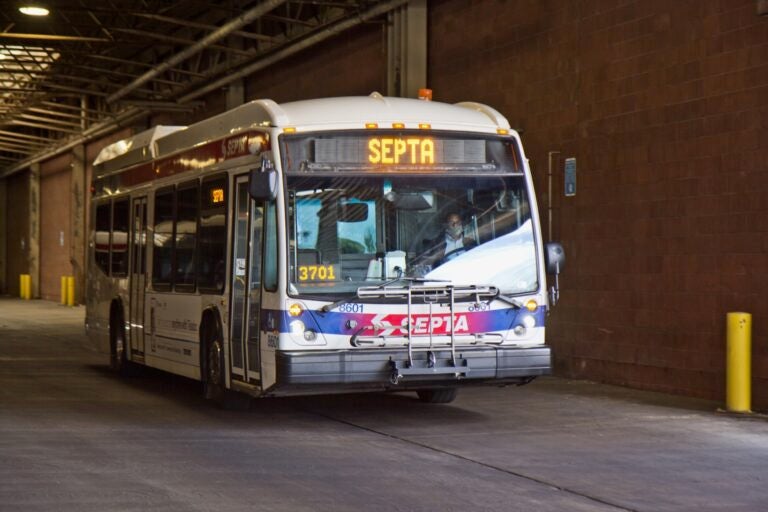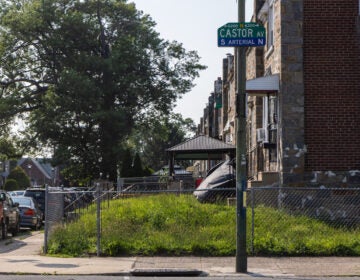A look into SEPTA’s new transit systems proposed for the Philadelphia suburbs
SEPTA wants to streamline bus services in Bucks and Montgomery Counties, and implement “microtransit” zones — an on-demand door-to-door transit service.

A SEPTA bus on May 21, 2020 (Kimberly Paynter/WHYY)
SEPTA is proposing an overhaul to bus lines across the Philadelphia region — they’re calling it “Bus Revolution.”
SEPTA wants to eliminate some local bus routes that run infrequently, for faster service on major lines. SEPTA officials say the proposal will allow more routes to run every 15 minutes or better, seven days a week between 6 a.m. and 9 p.m.
SEPTA also wants to do away with bus routes in ten suburban communities and replace them with a whole new mode of public transit. Microtransit would be mobile, on-demand services that riders can request by phone call or a new SEPTA app — which is still in the works.
Daniel Nemiroff, manager of planning programs at SEPTA, said the proposed changes will meet the needs in “areas of higher density, higher demand,” weighted with demographic factors like income and race.
Nemiroff said the plan is about serving more people using the same resources.
Community members still have time to share input on the draft, with a few more “open houses” and community conversations (though these are mostly in Philadelphia) and an online survey. On SEPTA’s transit app, riders can see what their new routes may look like.
Pushback against SEPTA’s bus plans in Lower Merion
The plan has received pushback in places that are losing some local routes, like Philadelphia’s Manayunk area, and in Lower Merion Township, Montgomery County.
In places like Lower Merion, riding may require a transfer or a farther walk to a more frequent line. SEPTA wants to streamline Route 44 into a new Route 555. Route 44 currently runs from Ardmore, along City Avenue to Bala Cynwyd, and down Interstate 76 into Center City. SEPTA is proposing the line just start in Ardmore and run through West Philadelphia into Center City instead, bypassing Bala Cynwyd. The Lower Merion area would lose other smaller lines like Route 52 in Gladwyne.
Nemiroff said there is minuscule ridership in Narberth and Gladwyne (Route 44 touches both), but far more in Ardmore, hence the streamlined Route 555.
Lonna Gordan, 36, lives in Bala Cynwyd and sees the bright side of losing line 44.
“Sometimes it literally just didn’t show up,” Gordan said. “I’d be planning to go to the city, to do something… And I thought I had the timing down. And instead I was late.”
She said she wouldn’t mind walking or a transfer if that means less wait time. Gordan described the 44 bus, which makes three small circles along its winding route, as “extremely confusing.” It serves as an example of why SEPTA believes the “revolution” is necessary — routes that are long and “inefficient,” according to SEPTA, with low ridership, are using up resources that could be spent on improving the places with more riders.
But others in Lower Merion are upset over losing local routes.
Tannia Schrieber, 49, lives in Penn Wynne and sees the overhaul as a potential hurdle for people with disabilities, older adults, and workers traveling to people’s homes.
“So much of a focus on making this community accessible has to do with what able-bodied people can use. It just troubles me,” Schrieber said.
Harley Cooper, a senior operations planner with SEPTA’s fixed routes department, summarized the changes; “We’re keeping the strongest, the highest ridership portion of that route, and we’re concentrating frequency on the portion of the route where people are riding.”
What is microtransit?
SEPTA wants to replace local bus routes with microtransit systems in Norristown and the Souderton and Telford area in Montgomery County, and Bristol and Bensalem townships in Bucks County, among others.
Matthew Edmond, executive director of the Montgomery County Transportation Authority, said the microtransit system is key for the ‘bus revolution’ to be effective.
“We’re really hoping it works… We feel it’s probably overall a better opportunity and a better option,” Edmond said. “That is, if microtransit works the way that it’s intended to work.”
That’s a question on others’ minds, too — will it work?
SEPTA is still fleshing out the details, but the concept is similar to rideshare services like Uber or Lyft. A rider can request a pick-up ahead of time or the same day, it picks them up at their door, and drops them off at their desired location.
SEPTA ran a pilot version of the microtransit system in lower Bucks County — an overnight service called the Owl Link meant to serve workers with late shifts. According to a Levittown Now report, SEPTA ended the program after several months because ridership wasn’t high enough to maintain the program. A SEPTA representative also said there was a “technology gap,” as many riders were not using the Owl Link app, and instead making calls for the service.
Cooper said she’s been concerned that app struggles will continue as the microtransit program rolls out, especially for seniors.
“I realize there’s definitely a need for travel training and we will set up those curriculums… partnering with libraries,” Cooper said.
Norristown, with more than 35,000 residents, is the densest of all the microtransit zones, according to Cooper. SEPTA is still deciding on the borders of the zone, Cooper said, which would impact how many people can use the service. But Cooper said it’s unlikely that 20 people would request the service at once.
SEPTA is dropping a number of transit corridors in Norristown and offering more frequent service on those that remain (main lines like Route 96). The microtransit is then meant to provide necessary “connectivity” within the municipality — where slow, infrequent routes like Route 90 were inefficient.
Bucks County officials hope the microtransit system will aid riders working late shifts at warehouses and hospitals, said Christian Regosh, transportation planner with the Bucks County Planning Commission.
“If you look at the layout of our current bus system now, it’s a little tough to understand it and it’s kind of intimidating for new riders,” Regosh said. “So I think that if we have these dynamic, more responsive, transit zones matched with these more streamlined and more easily to understand bus routes, I think that will make transit overall more useful to the residents of Bucks in the long term.”
Regosh said he’s optimistic about microtransit, looking at how similar programs have been “successful in other markets across the United States.”
SEPTA’s next steps
SEPTA will review public comments they’ve received so far, and make adjustments as appropriate. It plans to present an updated version in early 2023, and offer further public engagement efforts. SEPTA’s goal is to present a final draft to its board in the summer of 2023, and use the rest of the year to implement the changes.
WHYY is your source for fact-based, in-depth journalism and information. As a nonprofit organization, we rely on financial support from readers like you. Please give today.






